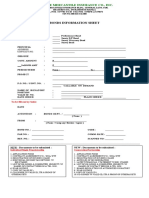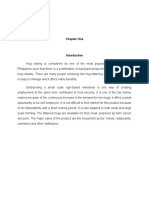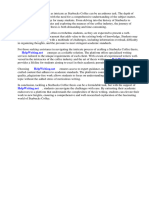0 ratings0% found this document useful (0 votes)
11 viewsSP and RP Survey
SP and RP Survey
Uploaded by
MaythuzarkhinThis document discusses different methods for collecting transportation data:
1. Revealed preference (RP) data collects information on people's actual travel behaviors and choices based on their current knowledge and options.
2. Stated preference (SP) data collects hypothetical choices people would make when presented with different travel options and attributes, allowing analysis of options not currently available.
3. Specific SP methods discussed include contingent valuation, conjoint analysis, and stated choice techniques. A case study demonstrates using contingent valuation to quantify people's willingness to pay for improved air quality.
Copyright:
© All Rights Reserved
Available Formats
Download as PPTX, PDF, TXT or read online from Scribd
SP and RP Survey
SP and RP Survey
Uploaded by
Maythuzarkhin0 ratings0% found this document useful (0 votes)
11 views14 pagesThis document discusses different methods for collecting transportation data:
1. Revealed preference (RP) data collects information on people's actual travel behaviors and choices based on their current knowledge and options.
2. Stated preference (SP) data collects hypothetical choices people would make when presented with different travel options and attributes, allowing analysis of options not currently available.
3. Specific SP methods discussed include contingent valuation, conjoint analysis, and stated choice techniques. A case study demonstrates using contingent valuation to quantify people's willingness to pay for improved air quality.
Copyright
© © All Rights Reserved
Available Formats
PPTX, PDF, TXT or read online from Scribd
Share this document
Did you find this document useful?
Is this content inappropriate?
This document discusses different methods for collecting transportation data:
1. Revealed preference (RP) data collects information on people's actual travel behaviors and choices based on their current knowledge and options.
2. Stated preference (SP) data collects hypothetical choices people would make when presented with different travel options and attributes, allowing analysis of options not currently available.
3. Specific SP methods discussed include contingent valuation, conjoint analysis, and stated choice techniques. A case study demonstrates using contingent valuation to quantify people's willingness to pay for improved air quality.
Copyright:
© All Rights Reserved
Available Formats
Download as PPTX, PDF, TXT or read online from Scribd
Download as pptx, pdf, or txt
0 ratings0% found this document useful (0 votes)
11 views14 pagesSP and RP Survey
SP and RP Survey
Uploaded by
MaythuzarkhinThis document discusses different methods for collecting transportation data:
1. Revealed preference (RP) data collects information on people's actual travel behaviors and choices based on their current knowledge and options.
2. Stated preference (SP) data collects hypothetical choices people would make when presented with different travel options and attributes, allowing analysis of options not currently available.
3. Specific SP methods discussed include contingent valuation, conjoint analysis, and stated choice techniques. A case study demonstrates using contingent valuation to quantify people's willingness to pay for improved air quality.
Copyright:
© All Rights Reserved
Available Formats
Download as PPTX, PDF, TXT or read online from Scribd
Download as pptx, pdf, or txt
You are on page 1of 14
SP Vs RP
Mg Htet Okkar Kyaw
PhD.CTE-2
Department of Civil Engineering
Yangon Technological University
Introduction
• In general transportation planning, surveys are meant to
capture travelers’ current travel behavior.
• For instance, one is interested in knowing the actual mode a
traveler is using, actual travel times, destinations, and so
forth.
• This is known as Revealed Preference (RP) data, as the
traveler is currently experiencing that behavior and making a
choice based on his or her knowledge of the available travel
options.
• Another type of data is based on Stated Responses (SR), in which
hypothetical situations are presented to the respondents, who are
then asked to choose based on the given attributes for each
alternative, without necessarily experiencing them in real situations
• SP surveys offer a great advantage for overcoming the problem of
the “new option”, whereby an analyst seeks to forecast the use of a
new alternative (such as high-speed rail), particularly when the new
option is very different from existing alternatives
• use of SP surveys has become widespread in a range of fields such
as marketing, transport, health economics, and agricultural and
environmental economics
Stated-preference (SP)
• Stated-preference techniques base demand estimates on an analysis of
the response to hypothetical choices; these can cover a wider range of
attributes and conditions than the real system.
• data from real markets is not available for predicting behaviour or
eliciting reliable preference functions, researchers have had to turn to
stated preference (SP) methods.
• These cover a range of techniques, which have in common the
collection of data about respondent’s intentions in hypothetical settings
• The three most common SP methods have been contingent valuation
(CV), conjoint analysis (CA) and stated choice (SC) techniques
Contingent Valuation Method (CVM)
• is used to estimate economic values for all kinds of ecosystem
and environmental services.
• It can be used to estimate both use and non use values, and it is
the most widely used method for estimating non-use values
• Contingent Valuation is a method of estimating the value that a
person places on a good. The approach asks people to directly
report their willingness to pay (WTP) to obtain a specified good,
or willingness to accept (WTA) to give up a good
• Contingent valuation is a survey based method of estimating
how much individuals would be willing to pay for
environmental or natural resource amenities, using a
hypothetical market
Value of highway landscaping: Survey travelers to
determine what they would be willing to pay for highway
landscaping,
how they value it relative to other trip characteristics with
established values, such as travel time.
Case study of CVM
Case study
• urbanization and severe air quality deterioration in Pakistan have
increased citizens’s concern towards air pollution.
• This study, conducted in November, 2016, aimed to develop
relationship between degraded air quality and resident’s
willingness to pay for improved air quality in city of Lahore,
Pakistan through contingent valuation method to quantify an
individual’s willingness to pay for improved air quality.
• Hypothetical market was created and 250 respondents, selected
through random sampling, were asked to respond to pre tested
questionnaire
• Results revealed that 92.5% of respondents showed positive willingness to
pay and average predicted willingness to pay by each person was $9.86 per
month.
• Pakistan is among the lower income countries with no rigid budget allocation
for improvement in air quality,
• People of Pakistan are willing to pay to reduce air pollution load.
• One of the factor which effected the positivity of willingness to pay is that, a
quite large number of people were suffering from pollution related
respiratory disorders like asthma, chronic bronchitis, wheezing, cough, and
chest congestion
• Only 7.5% of respondents were not interested to pay for improved air quality
which reported unconcerned attitude and lack of environmental awareness.
Conjoint analysis
• Conjoint analysis is a form of statistical analysis that firms use
in market research to understand how customers value
different components or features of their products or services
Stated Choice Method
• Stated choice studies are similar to CA methods insofar as respondents are
presented with a number of hypothetical alternatives; however, the two
methods differ in terms of the response metric
• SC methods typically present only a few alternatives at a time (and in most
cases only two), changing them and having respondents repeat the choice task
• CA tasks typically present respondents with a relatively large number of
alternatives, simultaneously, to rate or rank
Revealed Preference Survey
• revealed preference theory looks at actual consumer choices within a
proxy market good or service
• Revealed preferences surveys (RP) are about choices that individuals
have actually made.
• In terms of a public transport surveys, the revealed information would
be the actual trip or trips made by the user considering origin,
destination, origin stop, destination stop, journey purpose, and the
mode of transport they chose to use from the available alternatives.
• The strong point of this type of survey is that it provides us with the
real choices made by users in a determined context of constraints.
Thank You For Your Kind
Attention
You might also like
- From Mobility to Accessibility: Transforming Urban Transportation and Land-Use PlanningFrom EverandFrom Mobility to Accessibility: Transforming Urban Transportation and Land-Use PlanningNo ratings yet
- Chenab Textile Mill, KathuaDocument33 pagesChenab Textile Mill, KathuaMj Payal100% (5)
- Chapter 6Document39 pagesChapter 6ferewe tesfayeNo ratings yet
- Bioeconomics - Lecture 6Document8 pagesBioeconomics - Lecture 6kt30041998No ratings yet
- Travel Cost Method (TCM)Document34 pagesTravel Cost Method (TCM)Ayub NurNo ratings yet
- Public Acceptance Towards Congestion Charge: A Case Study of BrisbaneDocument13 pagesPublic Acceptance Towards Congestion Charge: A Case Study of BrisbaneShyam SunderNo ratings yet
- Contingent ValuationDocument31 pagesContingent ValuationTNo ratings yet
- 09 - Chapter 3 PDFDocument30 pages09 - Chapter 3 PDFvaishali PanjabiNo ratings yet
- 8 - Real Life HTADocument34 pages8 - Real Life HTAgunanti1307No ratings yet
- Factors Affecting The Service Quality in Public Bus Transportation in Sri LankaDocument8 pagesFactors Affecting The Service Quality in Public Bus Transportation in Sri LankaKumaresvaranNo ratings yet
- Term Paper Contingent Choice MethodDocument10 pagesTerm Paper Contingent Choice MethodPreetam Pandey100% (3)
- Transportation Infrastructure Projects: From Conception To ImplementationDocument49 pagesTransportation Infrastructure Projects: From Conception To ImplementationParth doshiNo ratings yet
- Chapter - 4 Research MethodologyDocument16 pagesChapter - 4 Research MethodologyRishabh jainNo ratings yet
- Methods and Procedures: o o o o o o o oDocument6 pagesMethods and Procedures: o o o o o o o oRyle AquinoNo ratings yet
- Final Report For Travel Time Data CollectionDocument5 pagesFinal Report For Travel Time Data CollectionN TNo ratings yet
- Vinni ProjectDocument62 pagesVinni ProjectmanasNo ratings yet
- MSCP 1Document20 pagesMSCP 1MurtazaNo ratings yet
- MGN206 Ca2Document36 pagesMGN206 Ca2aslam khan0% (1)
- Methods of Demand Forecasting: Submitted BY Hari Prasath S (2066B) B.E-ME (15) G-1Document29 pagesMethods of Demand Forecasting: Submitted BY Hari Prasath S (2066B) B.E-ME (15) G-1GokulNo ratings yet
- Transportation EngineeringDocument3 pagesTransportation EngineeringCHRISTIAN F. MAYUGANo ratings yet
- Business ResearchDocument12 pagesBusiness ResearchHannah Faye ValdezNo ratings yet
- IJRPR19123Document8 pagesIJRPR19123sushantnanaware2000No ratings yet
- Segmentation Analysis of Users' Preferences Towards Bus Service QualityDocument8 pagesSegmentation Analysis of Users' Preferences Towards Bus Service QualityAlex LakeNo ratings yet
- Contingent Valuation Method: Dr. Carla GuerrieroDocument25 pagesContingent Valuation Method: Dr. Carla GuerrieroNeighvestNo ratings yet
- Cost-Benefit Analysis in Poor and Rich Countries: Is It Different?Document26 pagesCost-Benefit Analysis in Poor and Rich Countries: Is It Different?ADBI EventsNo ratings yet
- Chapter 1 5Document47 pagesChapter 1 5renz calderonNo ratings yet
- Quantitative Research CharacteristicsDocument40 pagesQuantitative Research CharacteristicsSumanjumanjiNo ratings yet
- Envrnmnt MNGT Printout - JamesDocument5 pagesEnvrnmnt MNGT Printout - JamesAshok G RoyNo ratings yet
- Toaz - Info Irctc Blackbook Project 2 PRDocument80 pagesToaz - Info Irctc Blackbook Project 2 PRRubin TevarNo ratings yet
- Survey Research For EltDocument31 pagesSurvey Research For EltParlindungan Pardede100% (3)
- Module 1: Introduction To Transportation Planning: by Rei Robin Roland Tumambing, CE, RMP Elective2EDocument54 pagesModule 1: Introduction To Transportation Planning: by Rei Robin Roland Tumambing, CE, RMP Elective2ENicole De LeonNo ratings yet
- Shaan Kumar Public PolicyDocument11 pagesShaan Kumar Public PolicyAnonymous Vn8Tif5YVkNo ratings yet
- Unit 1 (Full) - Valuing The EnvironmentDocument7 pagesUnit 1 (Full) - Valuing The EnvironmentEsai Kanaga YadavNo ratings yet
- DocumentDocument4 pagesDocumentjiero.fernandezNo ratings yet
- Shaan Kumar Public PolicyDocument11 pagesShaan Kumar Public PolicyAnonymous Vn8Tif5YVkNo ratings yet
- Travel Demand ManagementDocument27 pagesTravel Demand ManagementPranav MishraNo ratings yet
- Critique 2Document19 pagesCritique 2Deepika LingamNo ratings yet
- Module 2Document24 pagesModule 2prajwalp4124No ratings yet
- Environmental Economics Travel Cost ApproachDocument5 pagesEnvironmental Economics Travel Cost ApproachAman SahuNo ratings yet
- Diwakar Project 2024Document37 pagesDiwakar Project 2024spdmilmaaNo ratings yet
- Chapter 2Document7 pagesChapter 2Ronna EvacuadoNo ratings yet
- TSL3113 Differences Between Qualitative and Quantitative Research MethodsDocument5 pagesTSL3113 Differences Between Qualitative and Quantitative Research MethodsYi Jing LoiNo ratings yet
- Performance EvaluationDocument67 pagesPerformance EvaluationJitendra GurjarNo ratings yet
- Denson MRDocument4 pagesDenson MRVishnu DevNo ratings yet
- Applied Marketing Session 4 Final NotesDocument12 pagesApplied Marketing Session 4 Final NotesMobeen KhanNo ratings yet
- MUTUADocument10 pagesMUTUABENARD LUKIBIANo ratings yet
- Data Analysis TechniquesDocument7 pagesData Analysis TechniquesMark Andrew Manalo GaelaNo ratings yet
- CHAPTER III EditedDocument4 pagesCHAPTER III Editedantonialmasco786No ratings yet
- IJRPR13068Document9 pagesIJRPR13068Karthik VNo ratings yet
- A Case Study in Panipat Thermal Power Station Colony, India: Willingness To Pay Estimates of Improved Air QualityDocument17 pagesA Case Study in Panipat Thermal Power Station Colony, India: Willingness To Pay Estimates of Improved Air QualityreaksiNo ratings yet
- Cost Benefit AnalysisDocument19 pagesCost Benefit AnalysisAsia ButtNo ratings yet
- A Comparative Study Between Globe and PLDT Based On Consumer PerceptionDocument25 pagesA Comparative Study Between Globe and PLDT Based On Consumer PerceptionHunter ZeroNo ratings yet
- Recreational Values of Forest Park Using The Contingent Valuation Method (Case Study Saravan Forest Park, North of Iran)Document11 pagesRecreational Values of Forest Park Using The Contingent Valuation Method (Case Study Saravan Forest Park, North of Iran)alisyahrahmiNo ratings yet
- Alagde PricemkDocument16 pagesAlagde Pricemkanton.alagdeNo ratings yet
- Module2 Session2-Slides Final PDFDocument34 pagesModule2 Session2-Slides Final PDFManoj KumarNo ratings yet
- Module2 Session2-Slides FinalDocument34 pagesModule2 Session2-Slides FinalManoj KumarNo ratings yet
- 19 19 1 PBDocument11 pages19 19 1 PBAnonymous koR9VtfNo ratings yet
- Sampling TechniquesDocument30 pagesSampling TechniquesMawutor AddatorviNo ratings yet
- Answer 3: Performance EvaluationDocument4 pagesAnswer 3: Performance EvaluationNajeeb KhanNo ratings yet
- Chapter 3Document8 pagesChapter 3DivaxNo ratings yet
- Lpe2501 Lecture Notes 4 Week 9 10Document9 pagesLpe2501 Lecture Notes 4 Week 9 10Wei En YeeNo ratings yet
- Week 1 Evening 1 Tourism Marketing PrinciplesDocument51 pagesWeek 1 Evening 1 Tourism Marketing Principlesdulutza999No ratings yet
- Introduction To Supply Chain Management-1Document10 pagesIntroduction To Supply Chain Management-1pradumna.shuklaNo ratings yet
- Timson Trade 3-In-1 CAIFDocument6 pagesTimson Trade 3-In-1 CAIFAlbert MantizaNo ratings yet
- PSP Lab FCA Wind Down Plan Template v1Document17 pagesPSP Lab FCA Wind Down Plan Template v1T MNo ratings yet
- CES (Chip Eng Seng) Salcon PTE LTD BVD 23 - 08 - 2022 13 - 31Document75 pagesCES (Chip Eng Seng) Salcon PTE LTD BVD 23 - 08 - 2022 13 - 31harryxwjNo ratings yet
- H-Birthday e A4Document3 pagesH-Birthday e A4Rosa Ana CampoNo ratings yet
- Chapter 1Document23 pagesChapter 1Pich Lanida100% (1)
- Report On Uber MarketingDocument14 pagesReport On Uber Marketingridoyshariar3No ratings yet
- 7903 - International Business StrategyDocument244 pages7903 - International Business StrategyJatin yadavNo ratings yet
- Production of MacrameDocument9 pagesProduction of MacrameNicole GludaNo ratings yet
- A Brief History: "We WillDocument66 pagesA Brief History: "We Willsummercrystal_naiduNo ratings yet
- Artelia Brochure - IndustryDocument2 pagesArtelia Brochure - IndustryFardhan AdamyNo ratings yet
- Chapter 11 Summary 2019Document5 pagesChapter 11 Summary 2019leoboyaliNo ratings yet
- CRM - Section B - Group8Document16 pagesCRM - Section B - Group8mansi manglaNo ratings yet
- Reports On Audited Financial Statements: CompanyDocument37 pagesReports On Audited Financial Statements: Companyhassan nassereddineNo ratings yet
- Free Water BillDocument1 pageFree Water BillDuurgaaNo ratings yet
- Acctg. Ed 1 - Unit2 Module 4Document13 pagesAcctg. Ed 1 - Unit2 Module 4Angel Justine BernardoNo ratings yet
- National Income (Notes) IMBADocument27 pagesNational Income (Notes) IMBASubham .MNo ratings yet
- Bond Info Sheet ContractorsDocument1 pageBond Info Sheet ContractorsJose Antonio ReyesNo ratings yet
- AgricultureDocument22 pagesAgricultureMariel Rivera-TabulogNo ratings yet
- 30 Most Common Sales Objections How You Can Handle Them Example ResponsesDocument30 pages30 Most Common Sales Objections How You Can Handle Them Example Responsesshyamity100% (1)
- Assignment StudentDocument28 pagesAssignment Studentgurdeep kaurNo ratings yet
- Forever Freedom Financial Rewards Plan US 08-2013Document15 pagesForever Freedom Financial Rewards Plan US 08-2013Dobler LilianaNo ratings yet
- Caso Louis Vuitton Cárdenas Martínez Neyra SosaDocument11 pagesCaso Louis Vuitton Cárdenas Martínez Neyra Sosa19100636No ratings yet
- Saynis f8 Students Somalia Exam TRADE PRINT READY 1 5 1 1Document5 pagesSaynis f8 Students Somalia Exam TRADE PRINT READY 1 5 1 1gosaweyne26No ratings yet
- Starbucks Coffee ThesisDocument5 pagesStarbucks Coffee Thesisafkojxato100% (2)
- Intermediate Accounting IIDocument10 pagesIntermediate Accounting IILexNo ratings yet
- S221. 5 Managing Inventory Throughout The Supply ChainDocument30 pagesS221. 5 Managing Inventory Throughout The Supply ChainANH TRẦN TIẾNNo ratings yet

























































































